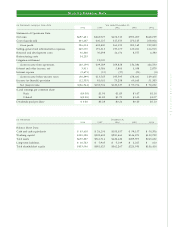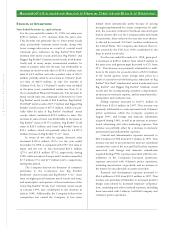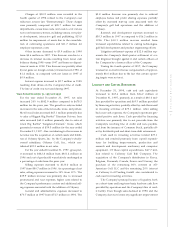Callaway 1998 Annual Report Download - page 19
Download and view the complete annual report
Please find page 19 of the 1998 Callaway annual report below. You can navigate through the pages in the report by either clicking on the pages listed below, or by using the keyword search tool below to find specific information within the annual report.
CALLAWAY GOLF COMPANY
17
The Company has commenced the remediation
phase and begun to identify and implement remediation
options for its critical systems. The Company expects to
complete this phase by mid-1999. Remediation for key
systems will primarily include altering the product or
software code, upgrading or replacing the product, rec-
ommending changes in how the product is used or retir-
ing the product.
In October 1997, the Company implemented a
new business computer system, which runs most of the
Company’s data processing and financial reporting soft-
ware applications and has in part addressed remediation
issues Company-wide. The manufacturer of the applica-
tion software used on the new computer system has rep-
resented that the software addresses the Y2K issue,
although recent testing of the software indicates that
some level of remediation may be required. The infor-
mation systems of the majority of the Company’s sub-
sidiaries have now been converted to the new system,
and the Company anticipates converting the remaining
material subsidiaries by mid-year 1999.
The Company presently plans to have completed
the four phases with respect to those systems which are
critical to its operations no later than the end of the
third quarter of 1999. Some non-critical systems may
not be addressed until after January 2000.
The total cost associated with assessment and
required modifications to implement the Company’s
Year 2000 Plan is not expected to be material to the
Company’s financial position. The Company currently
estimates that the total cost of implementing its Year
2000 Plan will not exceed $6.0 million. This prelimi-
nary estimate is based on presently available information
and will be updated as the Company continues its
assessment and proceeds with implementation. In par-
ticular, the estimate may need to be increased once the
Company has formulated its contingency plan. The
total amount expended on the Year 2000 Plan through
December 1998 was $633,000, of which approximately
$414,000 related to repair or replacing of software and
related hardware problems and approximately $219,000
related to internal and external labor costs.
If the Company’s new business computer system
fails due to the Y2K issue, or if any computer hardware
or software applications or embedded systems critical to
the Company’s manufacturing, shipping or other
processes are overlooked, or if the remaining subsidiary
conversions are not made or are not completed timely,
there could be a material adverse impact on the business
operations and financial performance of the Company.
Additionally, there can be no assurance that the
Company’s critical suppliers and customers will not
experience a Y2K-related failure that could have a mate-
rial adverse effect on the business operations or financial
performance of the Company. In particular, if third
party suppliers, due to the Y2K issue, fail to provide the
Company with components or materials which are nec-
essary to manufacture its products, with sufficient elec-
tric power and other utilities to sustain its manufactur-
ing process, or with adequate, reliable means of trans-
porting its products to its customers worldwide, then
any such failure could have a material adverse effect on
the business operations and financial performance of the
Company.
The Company has not yet established a contin-
gency plan, but intends to formulate one to address
unavoided or unavoidable risks and expects to have the
contingency plan formulated by July 1999. In particular,
with respect to third party component suppliers, the
Company will develop contingency plans for suppliers
determined to be at high risk of noncompliance or busi-
ness disruption. The contingency plans are being devel-
oped on a case-by-case basis, and may include booking
orders and producing products before anticipated busi-
ness disruptions. Even so, judgments regarding contin-
gency plans – such as how to develop them and to what
extent – are themselves subject to many variables and
uncertainties. There can be no assurance that the
Company will correctly anticipate the level, impact or
duration of noncompliance by suppliers that provide
inadequate information. As a result, there is no certain-
ty that the Company’s contingency plans will be suffi-
cient to mitigate the impact of noncompliance by sup-
pliers, and some material adverse effect to the Company
may result from one or more third parties regardless of
defensive contingency plans.
Estimates of time, cost, and risk are based on cur-
rently available information. Developments that could
affect estimates include, but are not limited to, the avail-
ability and cost of trained personnel; the ability to locate
and correct all relevant computer software code and sys-
tems; cooperation and remediation success of the
Company’s suppliers and customers (and their suppliers
and customers); and the ability to correctly anticipate
risks and implement suitable contingency plans in the
event of system failures at the Company or its suppliers
and customers (and their suppliers and customers).
Euro Currency
Many of the countries in which the Company sells its
products are Member States of the Economic and
Monetary Union (“EMU”). Beginning January 1, 1999
Member States of the EMU have the option of trading
























